Soviet style: Frédéric Chaubin puts cosmic Communist constructions in the frame

The ‘hidden architectural gem’ is an established trope of the modern age, something to be unearthed by an eager photographer and then propagated via the internet to an eager, ever increasing audience. Frédéric Chaubin’s visual exploration of the ‘fourth and final age of Soviet architecture’ is a case in point.
The sheer space-age strangeness of these buildings shows an architecture that was still ideologically charged, a noble communist assault against the value of abstract forms that Western designers had begun to turn their back on by the 1970s and 80s. A single example of any of these structures would throw a Western conservation body worth their salt into paroxysms of delight, for Chaubin presents a hidden history of architectural inventiveness, with a heft, solidity and fantastical outlook that today’s icon builders can only dream of.
The material of choice is concrete; raw, rich, sculptural, evocative and truly inspirational concrete, seen here fulfilling every dream of the early modernists and more. There is also chaos at work, a chaos that predates the parametric wet dreams and CGI-inspired voluptuousness of so much modern design, depending instead on the slide rule and certainty of poured, hammered concrete and exotically abstract decoration. Drawn from the far reaches of the USSR, soon to be fragmented away from the motherland, the diversity of the 90 featured buildings foreshadows the chaos that led to the end of the Soviet era.
Today, the heady combination of Soviet style and architectural extravagance is very much back in fashion, and the tragic ideological missteps that underpin so many of these structures is easily overlooked. As Chaubin notes in his introduction, ‘the Soviet Union was a labour camp, but also a gigantic holiday camp, a place where recreational activities were rigorously planned’.
From stadiums to scientific laboratories, playgrounds to health clubs, these buildings carried the torch of Constructivism, mixed in with American Googie, and central European Expressionism, creating slices of space age modern baroque that are now forgotten, faded and patched. For the most part, the infrastructure and systems that spawned this work have long since evaporated, leaving behind examples of high architectural melodrama that can never be repeated.
This article was originally published in January 2011 and updated for the book’s September 2017 reissue

The architecture faculty at the Polytechnic Institute of Minsk, Belarus, and its succession of overhanging lecture theatres, by V Anikin and I Yesman, 1983
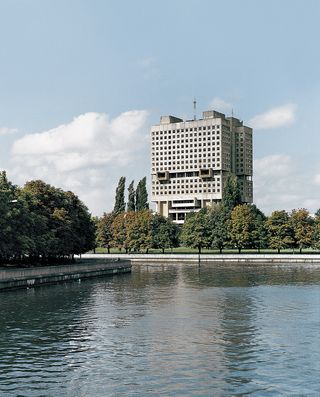
The anthropomorphic House of Soviets in Kaliningrad stands on the site of the Saxon castle of Königsberg. Begun in 1974, its construction was never completed because of its structural flaws and the collapse of the USSR
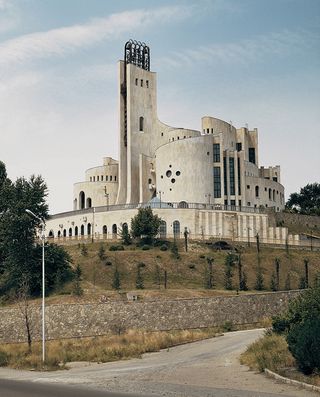
Palace of Ceremonies in Tbilisi, Georgia, by R Dzhorbenadze and V Orbeladze, 1985

Soviet embassy in Havana, Cuba, by Alexander Rochegov, 1985

Druzhba sanatorium in Yalta, Ukraine, by I Vasilevsky and Y Stefanchuk, 1985
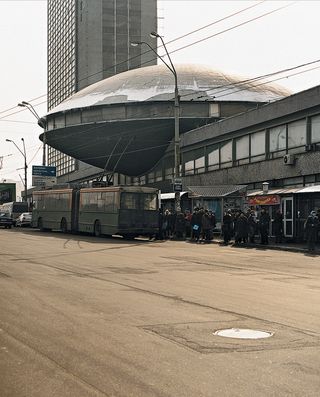
Ukrainian Institute of Scientific and Technological Research and Development in Kiev, Ukraine, by L Novikov and F Turiev, 1971
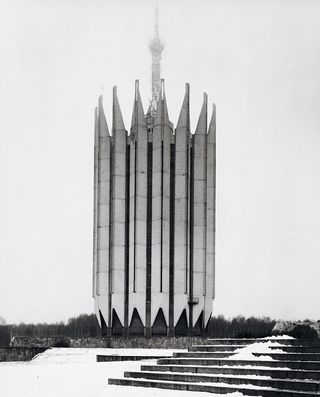
Institute of Robotics and Technical Cybernetics in St Petersburg, Russia, by S Savin and B Artiushin, 1987

Built in the 19th century, the Ninth Fort at Kaunas in Lithuania was used by the Soviet NKVD as a detention centre and then by the German occupying forces. The 32 metre-high memorial stands on the site of mass executions carried out during the Holocaust. This spectacular evocation of suffering and death was designed by the sculptor Alfonsas Ambraziunas in 1983
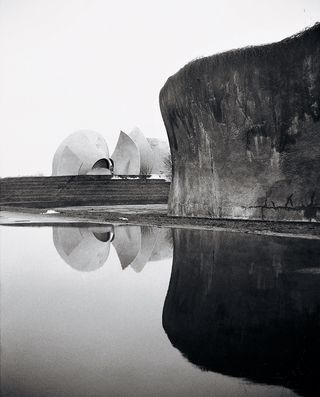
Crematorium in Kiev, Ukraine, by A Miletski, 1985
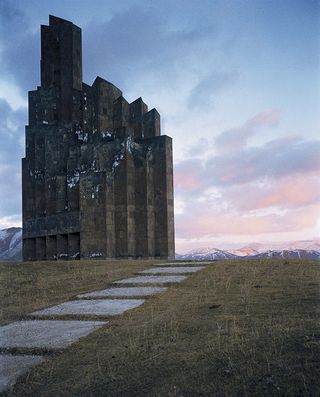
Monument to the Battle of Bash-Aparanin Armeniam, by Rafael Israelyan, 1979
INFORMATION
Frédéric Chaubin. Cosmic Communist Constructions Photographed, £ 34.99, published by Taschen
Wallpaper* Newsletter
Receive our daily digest of inspiration, escapism and design stories from around the world direct to your inbox
Jonathan Bell has written for Wallpaper* magazine since 1999, covering everything from architecture and transport design to books, tech and graphic design. He is now the magazine’s Transport and Technology Editor. Jonathan has written and edited 15 books, including Concept Car Design, 21st Century House, and The New Modern House. He is also the host of Wallpaper’s first podcast.
-
 Enjoy ocean and jungle bliss at Bespoke Tulum’s residences in Mexico
Enjoy ocean and jungle bliss at Bespoke Tulum’s residences in MexicoBespoke Tulum is an exclusive hospitality complex designed by Muro Rojo Arquitectura on Mexico’s Caribbean coastline
By Sofia de la Cruz Published
-
 In Van Cleef & Arpels’ high jewellery, the archival meets the au courant
In Van Cleef & Arpels’ high jewellery, the archival meets the au courantVan Cleef & Arpels pays tribute to its rich heritage with a captivating high jewellery collection
By Hannah Silver Published
-
 New Nothing Ear and Ear (a) earbuds: audio innovation with a retro nod
New Nothing Ear and Ear (a) earbuds: audio innovation with a retro nodNothing’s new Ear and Ear (a) earbuds, drawing inspiration from vintage portable hi-fi and packed with updates, help the company maintain its status as an audio innovator
By Jonathan Bell Published
-
 ‘Package Holiday 1968-1985’: a very British love affair in pictures
‘Package Holiday 1968-1985’: a very British love affair in pictures‘Package Holiday’ recalls tans, table tennis and Technicolor in Trevor Clark’s wistful snaps of sun-seeking Brits
By Caragh McKay Published
-
 ‘Art Exposed’: Julian Spalding on everything that’s wrong with the art world
‘Art Exposed’: Julian Spalding on everything that’s wrong with the art worldIn ‘Art Exposed’, Julian Spalding draws on his 40 years in the art world – as a museum director, curator, and critic – for his series of essays
By Alfred Tong Published
-
 Marisol Mendez's ‘Madre’ unpicks the woven threads of Bolivian womanhood
Marisol Mendez's ‘Madre’ unpicks the woven threads of Bolivian womanhoodFrom ancestry to protest, how Marisol Mendez’s 'Madre' is rewriting the narrative of Bolivian womanhood
By Sofia de la Cruz Published
-
 Photo book explores the messy, magical mundanity of new motherhood
Photo book explores the messy, magical mundanity of new motherhood‘Sorry I Gave Birth I Disappeared But Now I’m Back’ by photographer Andi Galdi Vinko explores new motherhood in all its messy, beautiful reality
By Hannah Silver Published
-
 Best contemporary art books: a guide for 2023
Best contemporary art books: a guide for 2023From maverick memoirs to topical tomes, turn over a new leaf with the Wallpaper* arts desk’s pick of new releases and all-time favourite art books
By Harriet Lloyd-Smith Published
-
 The best photography books for your coffee table
The best photography books for your coffee tableFlick through, mull over and deep-dive into the best photography books on the market, from our shelves to you
By Sophie Gladstone Published
-
 Behind the scenes of Stanley Kubrick’s The Shining: new book charts the making of a horror icon
Behind the scenes of Stanley Kubrick’s The Shining: new book charts the making of a horror iconPublished in February 2023 by Taschen, a new collector's book will go behind the scenes of Stanley Kubrick’s The Shining, charting the unseen making of a film that defined the horror genre
By Harriet Lloyd-Smith Published
-
 Brad Walls’ aerial view transforms pools into artwork
Brad Walls’ aerial view transforms pools into artworkAerial photographer Brad Walls provides a crisp conclusion to the summer months with new book Pools From Above – you’ll want to dive right in
By Martha Elliott Last updated